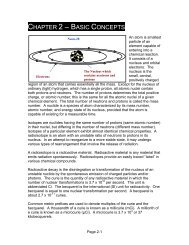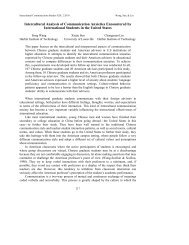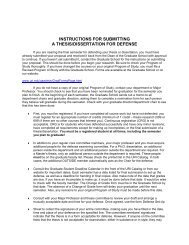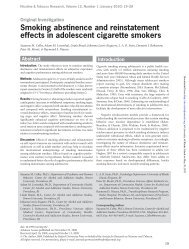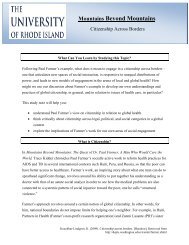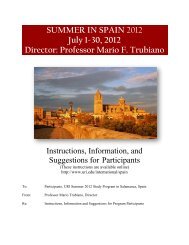asian approaches to human communication - University of Rhode ...
asian approaches to human communication - University of Rhode ...
asian approaches to human communication - University of Rhode ...
You also want an ePaper? Increase the reach of your titles
YUMPU automatically turns print PDFs into web optimized ePapers that Google loves.
Intercultural Communication Studies XII-4 2003 Asian Approaches <strong>to</strong> Human Communication<br />
Throughout their long his<strong>to</strong>ries, Asians have had intercultural contacts with<br />
different people, ideas, and products from different societies that must have<br />
initially caused confusion and friction in their communities. It is highly<br />
rewarding for Asiacentric <strong>communication</strong> his<strong>to</strong>rians <strong>to</strong> investigate how each<br />
Asian society has his<strong>to</strong>rically coped with these intercultural encounters. In<br />
particular, as Lee (2001) observes, the coexistence <strong>of</strong> indigenous and foreign<br />
religions, which indicates some openness and <strong>to</strong>lerance for heterogeneous<br />
elements in Asia, can be a very important area <strong>of</strong> inquiry <strong>to</strong> theorize about how<br />
<strong>to</strong> solve intercultural problems and conflicts in <strong>human</strong> <strong>communication</strong>. In this<br />
connection, Lee (2001) goes so far as <strong>to</strong> say that “The song <strong>of</strong> the East is a song<br />
<strong>of</strong> <strong>to</strong>lerance, which can inject a new harmony in<strong>to</strong> the music <strong>of</strong> the West” (p. 28).<br />
Insights also can be obtained in<strong>to</strong> allocentric and integrative ways <strong>of</strong> adapting<br />
mutually <strong>to</strong>ward harmonious <strong>communication</strong> (Miike, 2002, 2003a).<br />
From an ethnohis<strong>to</strong>rical perspective, for example, Toyama (1994) models<br />
what he calls “<strong>communication</strong> archetypes” <strong>of</strong> Japanese people. He theorizes<br />
about the mechanism and process <strong>of</strong> how the Japanese have eventually<br />
integrated something foreign in<strong>to</strong> their indigenous culture by analyzing the<br />
1450-year intercultural his<strong>to</strong>ry <strong>of</strong> Japan. He directs special attention <strong>to</strong> the longstanding<br />
coexistence <strong>of</strong> the indigenous superbeings (kami) and the imported<br />
Buddhist deities (ho<strong>to</strong>ke). He then applies his theoretical model <strong>to</strong> his own<br />
lifetime experiences <strong>of</strong> intercultural encounters and other short-term cases <strong>of</strong><br />
Japanese cross-cultural adjustment.<br />
It goes without saying that Asia has not been always successful in resolving<br />
conflicts peacefully or in respecting differences harmoniously. Indeed, as<br />
Funabashi (1993) writes, “Whenever unity seemed ascendant in the Asian world,<br />
his<strong>to</strong>ry intervened” (p. 76). Different versions <strong>of</strong> Asian his<strong>to</strong>ries reveal that<br />
harmony was, and is, <strong>of</strong>tentimes a mask <strong>of</strong> oppression or a means <strong>of</strong> survival<br />
within and between Asian nations. All Asian countries have extensively<br />
experienced the aggression and dominance <strong>of</strong> Western empires. Furthermore,<br />
Japan made the fatal mistake <strong>to</strong> invade other Asian nations under the false<br />
ideology <strong>of</strong> the “Greater East Asia Coprosperity Sphere.” Asiacentrists should<br />
not waste many his<strong>to</strong>rical pains in Asia that can serve as valuable assets in<br />
theorizing about the Asiacentric ethics and competence <strong>of</strong> global/local<br />
harmonious <strong>communication</strong>.<br />
As brutal wars, unethical invasions, and ethnic conflicts around the globe<br />
still continue, what would be the messages <strong>of</strong> Asian his<strong>to</strong>ries about what is right<br />
and what is wrong in <strong>human</strong> <strong>communication</strong> in order not <strong>to</strong> repeat past mistakes?<br />
From the Tibetan experience, The 14th Dalai Lama advances two fundamental<br />
propositions <strong>to</strong>ward peace <strong>communication</strong>: (1) Human problems can be solved<br />
through <strong>human</strong> understanding; and (2) All <strong>human</strong> beings seek happiness and<br />
avoid suffering (Miike, 2001). One <strong>of</strong> the possible Asiacentric his<strong>to</strong>rical<br />
50




